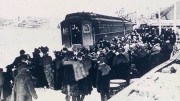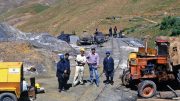September is my tenth year at The Northern Miner, and to mark the occasion, I’m being honoured with a choice of either a pen set or an extra week of holidays. It will be a tough decision. . . . All kidding aside, it has been a remarkable run. It’s by far the longest stretch that I have ever worked for one company. As a geologist, it is pretty rare to be employed for such a length of time.
That’s right, I still consider myself a geologist, despite being labelled as, horror of all horrors, a journalist. I am often asked how I ended up writing for The Northern Miner, considering that I haven’t taken an English class since high school. I was in the right place at the right time, or the wrong place at the wrong time, depending on how you look at it. When I applied for the position, my ever- supportive family exclaimed: “Are you crazy? You can’t write.” My paycheck every two weeks proves I’ve managed to fool everyone so far.
Geologists are a strange breed. They love rocks (more so if they prove uneconomic) and will endure months of solitary isolation, long hours and poor pay. They have been known to lick drill core, much to the amazement and amusement of drillers. They are an employer’s dream. If there ever was a profession that needed a union, geologists are it. With the recent upturn in the mining sector, geologists are in short supply. I recently overheard a senior mining executive jokingly remark that now is the time that every geologist should be cashing in with demands to double his salary.
My first job upon graduating from Dalhousie University in the mid-1980s was with Seabright Resources, a junior Nova Scotia-based company exploring for gold in the Meguma terrain. At the time, Seabright was one of a couple dozen companies investigating the potential of the historic gold mining camp, noted for its spectacular, nuggety specimens hosted in narrow quartz veins. It was the days of flow-through financing, and Seabright quickly grew to well over 200 employees.
Seabright took centre stage in Nova Scotia after acquiring the formerly producing Gays River lead-zinc mine. The mill was refurbished to process bulk samples from two advanced-stage underground gold projects: Beaver Dam and Forest Hills.
My first year with Seabright was marked by a swanky company Christmas dinner party, held in one of the Halifax hotels. Santa Claus, the surprise guest at the end of the evening, personally handed out year-end bonuses of up to $1,000 in cash or shares to everyone in attendance. It’s amazing how quickly the fortunes of a company can turn. The next year, which was marked by the Black Monday stock market collapse of October 19, 1987, there was no Christmas party. Instead, everyone received a $25 gift certificate from the local IGA supermarket.
Seeking to establish a presence in North America, WMC of Australia acquired Seabright in early 1988 during an unsolicited acquisition buying spree. Having done not a stitch of due diligence, WMC acquired what it thought were two producing mines with the Seabright purchase. I remember the shocked expressions when WMC management arrived for an official tour of the Beaver Dam project, only to find out we were struggling to prove up reserves. WMC later unsuccessfully sued the former directors of Seabright.
I spent a year and a half underground at Beaver Dam. The claustrophobic nature of underground mining affects people differently. The only time I had a problem was when I had to climb a couple of hundred feet in small development raises to sample the face and provide direction for the next round. Precariously perched on a ladder held in position by only a rock-bolt, I always felt a bit of anxiety wondering if the loose rock on the ceiling would stay put until I had safely exited.
A close friend of mine who worked at Beaver Dam liked to nap underground. After lunch, he would find a quiet, inactive heading, turn off his lamp and snooze for an hour or so, earning the respect and admiration of many. The only close call I had at Beaver Dam occurred during the establishment of a crosscut in a faulted area. While waiting for the area to be secured with rock-bolting, a piece of jagged “loose,” the size of a piano, fell from the ceiling within a couple of metres of where I was standing. I was lucky; the underground shift boss was not. He had been crouched directly underneath, repairing a jack-leg drill. The piece of loose almost took his leg clean off.
I have no greater respect or admiration for those who have chosen to put bread and butter on their tables by working underground. It’s a thankless profession that carries an enormous amount of risk, as well as health concerns. The isolated and remote nature of mines often takes individuals away from their families for extended amounts of time.
For that, miners here in North America are well paid, and deservedly so; it’s an unforgiving job. I wish miners in other regions of the world, such as Africa and South America, garnered the same wages. It would put everyone on a level playing field. It’s sad to hear someone like Robert Friedland, chairman of Ivanhoe Mines, who made hundreds of millions on the sale of the Voisey’s Bay nickel discovery in Labrador, extol the cost savings his new copper-gold discovery in Mongolia will potentially enjoy by not having to paying a United Steelworkers of America union member US$30 per hour to go underground. Instead, Friedland says he can hire a Chinese miner who will happily go underground with a smile on his face for US$200 per month.
Shortly after the Australians took over, I left Seabright to seek my fame and fortune on the West Coast. I was hired by Newhawk Gold Mines as an underground geologist at the remote Sulphurets gold-silver project, north of Stewart in northern British Columbia. The region gets hammered in the winter by snow, with accumulations averaging something like 20 ft. annually. It was a four-week in/two-week out rotation — great for the social life.
Newhawk was employing contract raise miners at Sulphurets from an outfit back east. That same outfit had been working in Nova Scotia at the Tangier gold mine. While at Seabright, we were constantly told by management to keep a close eye on the miners to make sure they didn’t “high-grade” (or pocket) the gold. It never posed a problem as we didn’t encounter any high-grade ore shoots at Beaver Dam until late in its life. Tangier was a different story. They were mining some spectacular looking material at the time. The gold in the Nova Scotia Meguma Terrain is coarse and nuggety, ranging up to the size of your thumb nail. Apparently after each blast, individuals were sorting through the quartz-vein material and high-grading a significant portion of the gold undetected.
For whatever reason, I never had a good vibe at Sulphurets, and five months later, at Christmas, I quit. It was a decision I did not regret, as a month later someone detonated an underground explosive depot at the mine, murdering two men. From that point onward, I made a conscious decision never to work underground again.
I turned-up next at Skyline’s Johnny Mountain gold mine in northern British Columbia, along the Alaskan Pan Handle. Johnny Mountain was put into production in 1988 by Reg Davis using flow-through funds, but without sufficient reserves. Faced with a diminishing return on his investment, Ron Shon, a successful real estate developer and early financial backer of Skyline, took control of the company. I spent the 1989 field season manning a surface exploration drilling rig in an unsuccessful bid to expand reserves.
Johnny Mountain was a fly-in/fly-out mine, sitting on a plateau atop a glacier-capped mountain in the Iskut River gold camp. The remoteness was underscored by the deaths of five miners and a flight crew member when a helicopter went down in a snow squall during a shift change at the mine in early 1990, several months after I had left.
While at Johnny Mountain, my dad became terminally ill with cancer. I returned to the Maritimes and spent the next three years running my dad’s business. He was self-employed as a manufacturer’s sales agen
t, specializing in the automotive field.
After my dad passed away, I wound down his business and once again ventured west. It was at this point that The Northern Miner was advertising for a staff writer at its Vancouver office. I met with John Kilburn, who was the western editor at the time, and after a half-hour interview he offered me the position. I accepted the offer, thinking I would give it one year and see where it leads to. Ten years later I’m still here, contemplating a pen set or an extra week of holidays.





Be the first to comment on "Odds ‘n’ sods: From geologist to scribe"